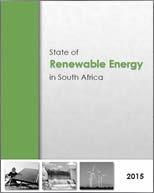State of Renewable Energy in South Africa
The South African journey towards large-scale deployment of renewable energy (RE) technologies shows an eclectic mixture of Government policy interventions, which converged with market forces between 2008 and 2012 to deliver an unprecedented, world-class programme.
This, the first State of Renewables Report in South Africa, traces the historic journey through the narratives of individual trailblazers and decision makers who influenced energy policy direction and, ultimately, RE implementation, in various ways. Building on these narratives, this report also highlights the main policy documents, legislative framework and institutions that are responsible for driving the RE agenda. It ends off by highlighting the integral role of research, development and human capital development, which are priorities for ensuring that South Africa keeps up with technological developments in this new field. A thread that runs through this report is that South Africa could not be where it is now without the financial and technical support of the international community and various Aid Agencies; there are too many to mention all of them in this report.
South Africa is fortunate in that, over and above its rich coal resources, it is also well endowed with nondepletable RE sources, notably solar and wind. The country has an average of more than 2,500 hours of sunshine per year and average direct solar radiation levels range between 4.5 and 6.5kWh/m2 per day, placing it in the top-3 in the world.
Details
- Source: South African government's Department of Energy
- Source Link: http://www.energy.gov.za/
- Publication Date: 09/2015
- Country: South Africa
- Language: English
